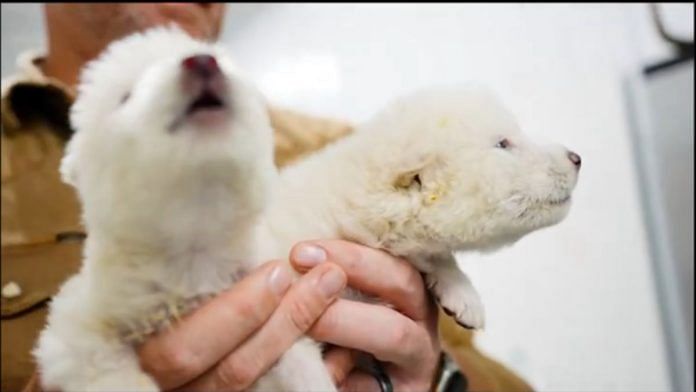New Delhi: Dire wolves have stepped out of the fantasy world of Game of Thrones and into reality—at least, that is what an American biotechnology company claims. Colossal Laboratories, a US-based biotechnology firm, announced Tuesday that it has ‘brought back’ the extinct dire wolf species using genetic engineering, marking their reappearance on Earth after 13,000 years.
According to Colossal, three dire wolves currently live at a 2,000-acre facility in the United States. Two male dire wolves—named Romulus and Remus—were born on 1 October through surrogacy, with domestic hounds carrying genetically modified embryos. They were joined on 30 January by a female, Khaleesi, conceived through the same process. These dire wolves have been raised and fed in a confidential Colossal facility in the US, to protect their location. However, on 8 April, Colossal introduced these pristine white dire wolves to the world by posting a video of them howling online.
“You’re hearing the first dire wolf howl in over 10,000 years,” read the post on X.
The scientists at Colossal used genome editing to carry out this process of ‘de-extinction’, as they call it. They first extracted DNA from ancient dire wolf fossils found in the US and reconstructed the dire wolf genome. A genome provides all the genetic information required about an animal, whether alive or extinct.
Using this reconstructed genome as a reference, Colossal then edited the genome of a grey wolf—the closest living relative of dire wolves. According to CRISPR, the grey wolf and dire wolf share 99.5 percent of their DNA code. By editing the grey wolf genome, Colossal was able to replicate the dire wolves’ white coats, broader heads, thicker legs, and larger jaws and teeth.
This genetically edited grey wolf genome was then used to create a modified embryo using grey wolf eggs, which was transplanted into a female hound for surrogacy. Therefore, the de-extinction process did not involve the use of actual dire wolf DNA but instead relied entirely on altered grey wolf genomes.
Colossal has not yet published any academic papers detailing the process, but the company announced on X that a scientific paper would be submitted for peer review ‘soon’.
Also Read: Search for an Indian Carl Sagan is on. Science influencers are being trained in labs and likes
Dire wolves and de-extinction
Dire wolves are known to have roamed the North American continent around 15,000 to 20,000 years ago, alongside woolly mammoths and bison, which served as their primary prey. Colossal’s genetic analysis indicated that dire wolves first appeared 2.5 million years ago but went extinct around 13,000 years ago due to several factors, including the scarcity of prey.
Colossal Biosciences, founded in 2021 and having raised over $400 million in funding, did not originally intend to de-extinct the dire wolf. Its principal goal was to ‘bring back the woolly mammoth’.
“We have the DNA, the technology and the leading experts in the field. Next, we will have the woolly mammoth back,” reads their website.
To that end, the company announced the creation of genetically modified ‘woolly mice’ in March this year, which they described as a ‘watershed moment’ in their pursuit of de-extincting the woolly mammoth by 2028.
“The de-extinction of the dire wolf and an end-to-end system for de-extinction is transformative and heralds an entirely new era of human stewardship of life,” said Chris Mason, a professor of genetics at Cornell and a member of the board of observers at Colossal, in a statement.
According to the company’s website and statements by chief science officer Beth Shapiro, the purpose of such de-extinction efforts is not solely to revive extinct animals but to contribute to broader conservation goals. A statement on the Colossal website says that de-extinction offers ‘deep ecological enrichment’ and that the company plans to release extinct species back into the wild to strengthen ecosystem resilience. The genetic editing techniques can also be applied to prevent endangered animals from going extinct.
Is it really de-extinction?
However, some scientists and academics have raised concerns about Colossal Laboratories’ approach, arguing that it does not truly constitute the ‘resurrection’ of an extinct species. Alex Young, a professor of genetics at the University of California, Los Angeles, took to X to highlight how the process had been ‘massively overhyped’.
“In other words, it’s not a dire wolf – it’s a gray wolf modified to be more like a dire wolf. That’s a cool achievement but they have not brought the dire wolf back,” he wrote.
An article in New Scientist magazine also explained that the three wolves currently with Colossal are grey wolves that have been genetically modified to ‘resemble dire wolves’. The article quotes US evolutionary biologist Beth Shapiro as saying that Colossal is operating by the morphological definition of an animal, meaning that “if it looks like the species, then it is the species.”
However, Shapiro herself stated in a 2016 paper that genetically edited animals are not ‘exact copies’ of extinct species. At the time, she was with the Genomics Institute at the University of California, Santa Cruz, and wrote about various processes that could facilitate ‘de-extinction’, including genome editing.
“None of the approaches will culminate in the birth of an organism that is an identical copy to one that is extinct,” wrote Shapiro. Instead, what will be possible is an ‘ecological proxy’ or stand-in for the extinct species in the current environment.
In the case of dire wolves Romulus, Remus and Khaleesi, even such proxy status may be questionable. While they have been hand-reared and are reportedly healthy and safe, Colossal has stated that there are no plans to re-wild them. They will “live out their best lives on an expansive preserve,” the company wrote in a post on X.
(Edited by Radifah Kabir)
Also Read: Posture panic hits researchers. IITs, AIIMS, big hospitals use smart microscopes now






